No matter how appealing, useful or beautiful your product is, you can't sell it if no one ever sees it. You have to get people into your shop — or, in the case of e-commerce, onto your website. In the age of shopping online, one of the most powerful tools available to get eyes on your goods is a search engine like Google, Bing or DuckDuckGo.
But how can small businesses set up their websites so searchers actually find their products — then go on to buy? Read on for all the tricks small businesses need to know about search engine optimization, or SEO.
In this article:
• How search engines work
• What is search engine optimization?
• SEO and search experience
• How to get started with SEO
• SEO keyword research
• How to plan SEO-friendly web copy
• Editing and writing your website copy for SEO
How search engines work
The internet is awash with websites full of information. The purpose of search engines is to catalogue, rank and organize all that information so that when you type a few words into that search box and press return, what you get back is a list of web pages that's a match for what you were looking for.
For example, let's say you're in the market for a new coffee mug, and you've got your heart set on supporting a local pottery business. You might search for "Winnipeg pottery studio mug" to find studios nearby that carry what you're looking for. A search engine will look at the words you typed in — the keywords — and match them to their database of web pages, displaying to you what they think is a good match. (Note: while there are several search engines, Google has by far the highest market share, so that's what we'll be using for our examples.)
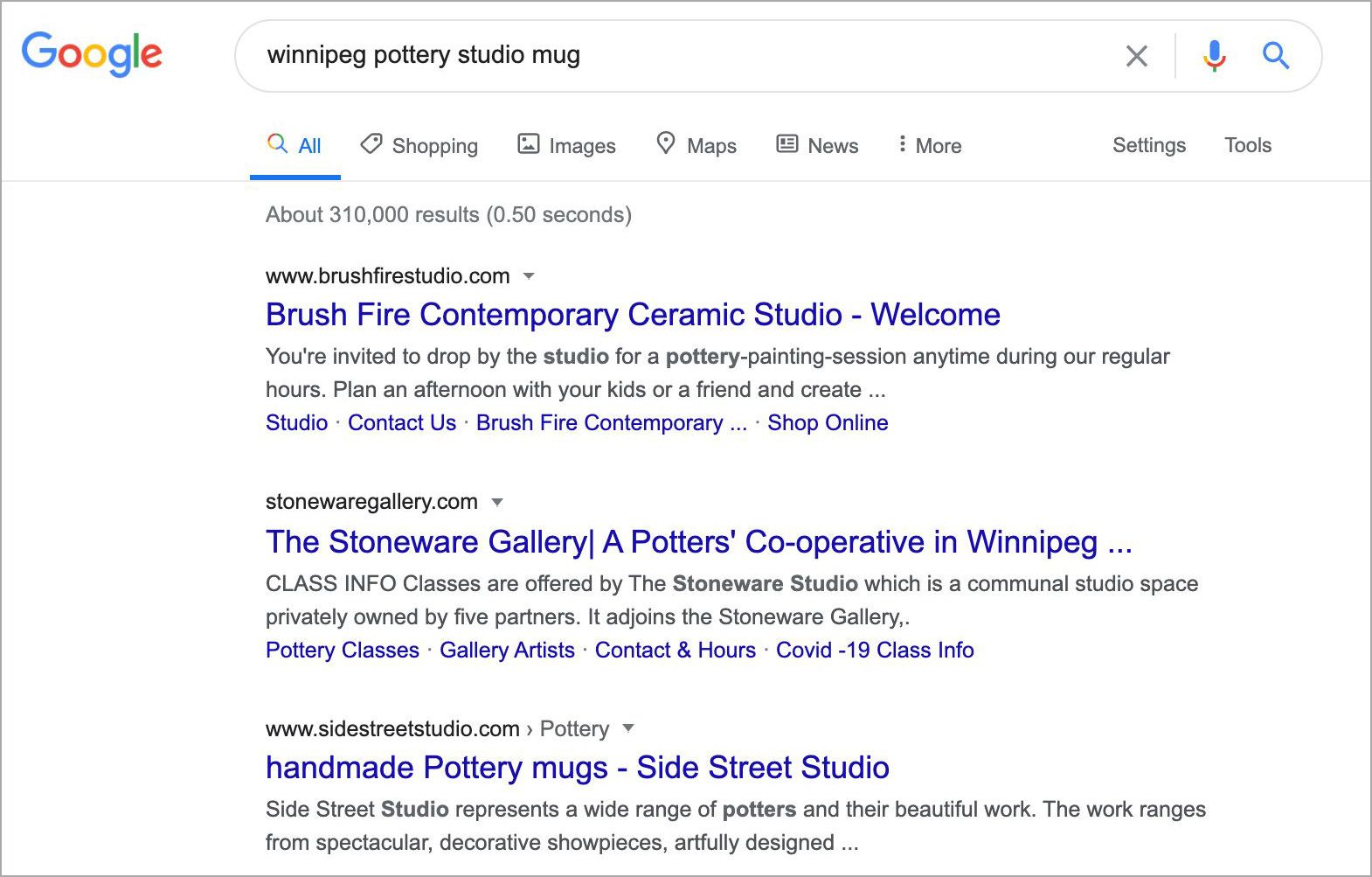
Delivering relevant results is trickier business than it might seem, and the way it works is opaque and covered by all sorts of NDAs. But it boils down to a few key steps. (In practice, these steps overlap and are quite a bit more complex.)
First, the search engine's "bots" (basically just some computer code) wander all over the internet, finding and logging web pages. Next the "algorithm" (more computer code) analyzes all these web pages and decides what they're about and what keywords they match with. Then the algorithm decides how "authoritative" each page is on each set of keywords. This has to do not just with the information on a website, but with the website itself: its age, for one, and its content as a whole, but also the quantity and quality of its inbound links, or the web pages that link to it.
Bonus: a lot of the tricks we talk about here work for online retail sites like Etsy, too, so you can use your keyword research (which we talk about later) in multiple ways.
What is search engine optimization?
Search engine optimization, or SEO, is the practice of organizing and formatting your website and its content so that search engines like Google will know what it's about and know that it's high quality – it’s the key to helping your target customers find your site.
The primary goal of SEO is usually ranking: appearing as high as possible on the list of results when people search certain keywords. (You might see the term SERP tossed about here, which stands for search engine results page, or the list of web pages you see when you search for things.) Research shows that pages that rank higher get more clicks.
These algorithm-created rankings are often called "organic" rankings, which simply means that they are results that got there naturally, not because someone paid for them to be there.
There are a few different aspects of SEO, like technical SEO (efficient code and a site that loads quickly), off-page SEO (trying to get more quality inbound links) and on-page SEO (the words and images on your site, plus technical factors).
For most small businesses, on-page SEO is the best place to start, and it's what we're going to focus on in this guide.
SEO and search experience
Many SEO experts like to point out that rankings aren't the only thing that matters. For one thing, achieving high rankings is useless if no one clicks through to your site. Plus a few things have to happen for those clicks to be meaningful. For one, the right people have to be making those clicks to get your site. And those people have to be actually looking at the page they land on (i.e., not "pogo sticking," or immediately clicking the back button to return to the SERP). Then, ideally, your site should be "converting" them, or getting them to take an action, whether that's buying something, signing up for an e-newsletter or following you on social media.
Let's say you live in Halifax and you run a business making custom furniture out of reclaimed wood. Because these are very heavy products, you don't offer shipping, only local pickup and delivery. You might have a blog post about your wood reclamation process that ranks highly in Google and gets you a lot of web traffic. But unless those site visitors are in the Halifax area (or willing to drive there to pick up furniture), they're not that useful to you.
Similarly, you might have a blog post about all the furniture you made from a well-known Halifax building that was torn down. You get a lot of web traffic from the Halifax area, because locals are curious about what happened to that building and interested in the idea that the building materials are being turned into new products. But if your website doesn't include a variety of calls to action — not just the ability to place an order, but the ability to stay engaged with your business over time until they might be ready to place an order (like following you on social media) — you won't get the conversions you want.
This whole process, from the time someone types some keywords into Google to the time they land on your site and see what's there, is the search experience. And when we talk about SEO, we need to take this entire experience into account.
How to get started with SEO
The first step in SEO is to do a bit of role-playing.
This thought process will vary depending on the kind of business you have, and the kind of customers you want. But essentially, you need to brainstorm what your potential customers might search for to get to your website and products.
For example, let's say you sell cross-stitch kits. The most obvious keywords people might use to find and buy your products would be "cross-stitch kits," "buy cross-stitch kits online" and other similar phrases.
But that's not enough to differentiate what you sell. There are a lot of cross-stitch kit companies online, and you're unlikely to be able to compete against all of them for high rankings. That's when you move toward the longer-tail keywords, which is a fancy way of saying keywords that are more specific and, generally, groupings of more words together.
So if you're based in Vancouver and you make cross-stitch kits aimed at beginners and kids that feature nature motifs, you might brainstorm keyword phrases like:
• easy cross-stitch kits
• Canada cross-stitch kits
• Vancouver cross-stitch kits
• cross-stitch kits for kids
• nature cross-stitch kits
• cross-stitch kits with flowers
And that's just the beginning: other possibilities might be "crafts for kids to do at home," "gifts for kids,” "Mother's Day gifts" or even something really specific like "blackberries art design" (if, say, you have a cross-stitch kit that features blackberries).
Jot down all of these in a notebook or in a document on your computer.
SEO keyword research
Many experts will tell you that you need to use online tools like Google Trends or SEMrush to research what people are searching for, so you can target the right keywords.
This is definitely useful in a lot of cases. But small maker businesses tend to be very niche, and search trend data isn't necessarily very effective when the numbers are small. (Let's face it, a lot fewer people are searching for cross-stitch kits than for new movies that are coming out or the latest Kardashian gossip.)
Plus, unless you're going to suddenly pivot from nature designs to cross-stitch kits featuring celebrities, it doesn't really matter to you if people are searching for the latter.
That said, it can be worth simply doing some random Googling to see what comes up to get some more ideas.
There are a few things to look at when researching keywords on Google:
• "Searches related to"
This will appear at the bottom of the SERP, and it can give you a good idea of what people are searching for.
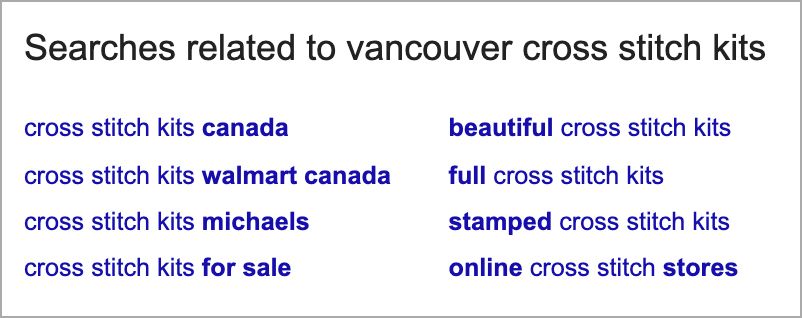
• "People also ask"
This is another area, closer to the top of the page, that displays related questions.
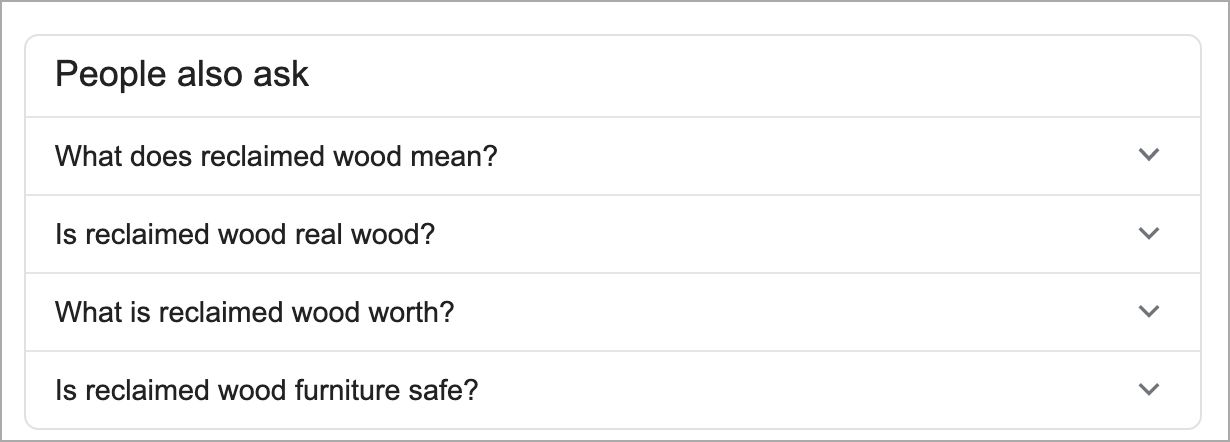
• Images
Google often displays a set of images in the SERP. You’ll see these accompanied by additional keywords people are searching for.
As you explore various search terms, you'll find related terms and concepts that can give you insight into what people might be looking for, both when it comes to products and when it comes to information. Jot down the terms you find that seem relevant to your business.
How to plan SEO-friendly web copy
Here is where we put all that keyword research into practice — almost. Before you start writing, it's a good idea to come up with a plan. You won't be able to do everything in one day, so start with a thorough list that you can keep going back to.
There are a few different places words can go on your website. You'll want to have a plan to update all of them. Add each of the items below to your list and note down what you have currently and what might be missing based on your keyword research.
Meta data and URL
Meta data is simply the section in your website code that describes your website and web pages. While it might be the same as some of the information that appears on the page itself, this code does not show up directly.
Historically, meta data includes a title, a description and tags, as well as some other information. We aren't going to worry about tags — they used to be important, but search engines don't pay attention to them anymore. (Note that meta data is also used elsewhere, like on social media, but we're going to focus on search for now.)
Each page on your site should have unique meta data. In other words, each page should have its own title and description. Most content management systems and website building tools (such as Wordpress, Shopify and Wix) have tools that help automate how this meta data is created. But it's a good idea to know how it happens so you can change it if necessary.
The meta title or page title is, in some ways, the most important set of words on your entire website. This is the place in your code where you tell Google what your site is. It's also the title that shows up in your web browser at the top of tabs and in bookmarks. Meta titles are the titles used in SERPs — in other words, they're the words you use to convince people to click on the link.
Meta descriptions also tell people what your site is about, but in more words. Google often uses them in the SERP too (underneath the titles), though sometimes it uses snippets of text it finds on the web page instead.
URLs are also important for clicks – a descriptive, keyword-rich URL helps people know what they're clicking on, both in search results and in general.
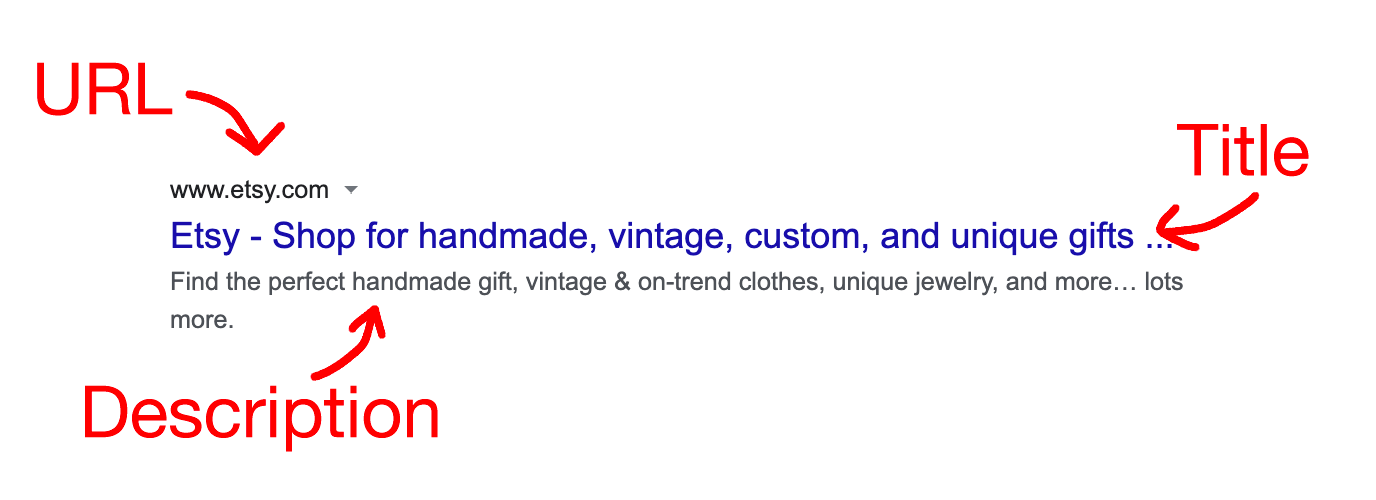
One thing to note: your site and its individual pages also have meta information that tells bots whether they should crawl your page or ignore it. Often, websites have search functions turned off when they are incomplete, to avoid having an unfinished website showing up in SERPs. Occasionally, people forget to turn them on. If you want your site to show up in search results, make sure you're not hiding it from bots.
Product names and descriptions
If you're selling products, then the names and descriptions of these products are a key part of your SEO strategy.
If each of your products has a unique web page, then this information might automatically become the meta data of a page, depending on the CMS you use.
Images
The images on your site can help with SEO, too. You might have noticed that Google often displays images when you search, or you might specifically search for images that match a certain set of keywords.
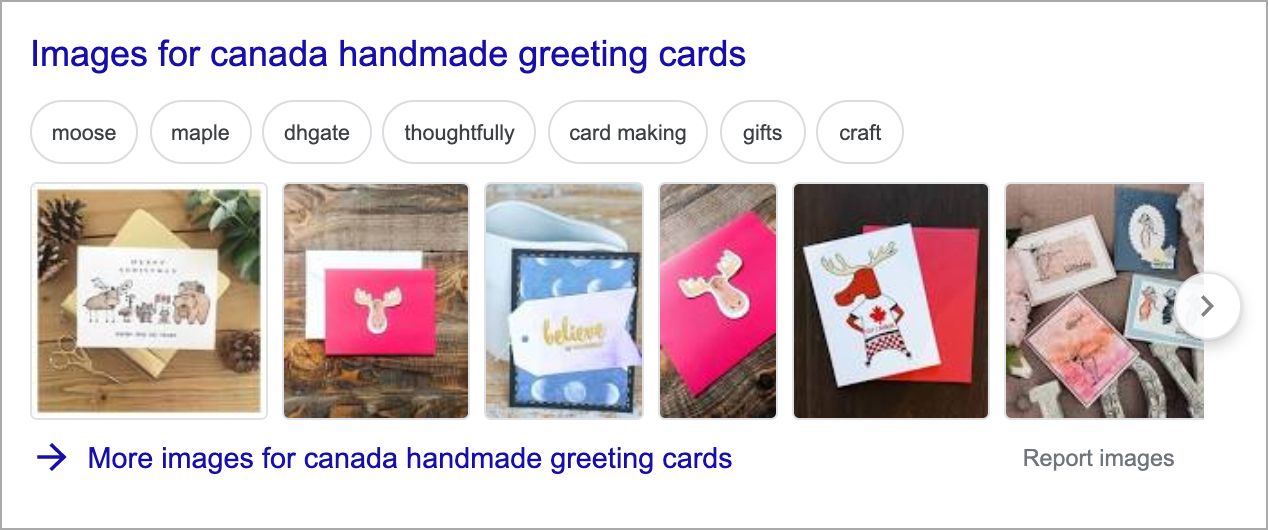
The words on the same page as the image matter, but so do the alt tags, the code tags that describe what the image is about. Make sure all your alt tags are informative and keyword rich. This is important not just for SEO, but for accessibility, too, for people using screen readers.
Other website copy
Last but not least is the rest of the copy on your website. This might include an about page, shipping information, an FAQ or articles about your craft. At this stage, think about not just improving the website copy you have, but adding some information, too.
Editing and writing your website copy for SEO
Now we get to the hard part. Or maybe the fun part?
First, remember that SEO, like building a website in general, is a process. It's overwhelming to think about getting it all done at once, but if you pick away at it, the SEO work will feel less daunting.
Here's a step-by-step plan to make it happen.
1. Edit your primary (home page) meta title and description
The meta title and description associated with your home page are basically the main description of your website, so you want them to be as informative and enticing as possible. Titles are extremely important for SEO, so that's where you want to put the most effort. Descriptions are less important when it comes to rankings, but they do have an effect on whether people will click.
One catch: Length matters. Google will truncate beyond a certain length, so it's best to keep titles under about 65 to 70 characters and descriptions around 150 to 160 characters. Yes, that includes spaces.
The title for your home page should include your business name as well as relevant keywords. For instance, it might be something like "Business Name: Reclaimed Wood Furniture in Halifax". (That's 50 characters, by the way.) Refer to your keyword research as you write this, and think about the core purpose of your business. Consider what your target customers would search for — and click on — if they were looking for your business.
The description should also include relevant keywords, and it should sum up your business in a couple of sentences. You want it to sound real, and interesting, and enticing enough that people want to learn more.
A good way to get a feel for effective titles and descriptions is to spend some time searching for various topics on Google. Look at the results. What draws your attention? What makes you skip to the next listing? What makes you want to click?
Tip: Many experts recommend using "title case" for meta titles as it's more likely to get people's attention. Title case means using capital letters on most words (generally the meaning words, as opposed to function words like prepositions and articles). It's different from sentence case, which means capitalizing only the first word of a sentence (as well as any proper nouns). Compare "Reclaimed Wood Furniture in Halifax" with "Reclaimed wood furniture in Halifax".
2. Edit your sub page meta titles and descriptions
Every page on your website has its own meta title and description, and they should all be unique.
Sound daunting? Not really. Most content management systems or website builders will automatically create these based on how you name your pages.
For example, Workshop uses Ghost as our CMS. We named this article "SEO Basics for Maker Businesses", and Ghost automatically made that the meta title, too. (It also took our excerpt, the description that appears on our home page and at the top of the article, and made it the meta description.) We can add our own titles and descriptions if and when we want to, but at least we know there's something there to start with.
Remember that you want your titles and descriptions to be keyword-rich, informative and enticing enough that people will want to click.
Check around your website to see what your CMS is doing, and decide if what's there is good enough. (You can see your titles at the top of your browser windows or tabs, and you can look deeper by looking at your site's page source.) Maybe you want to change some of them, or all of them, or perhaps what you have is working for you.
3. Edit your URLs
It's important that your URLs be meaningful, and include keywords. This is for a few reasons.
First, it's human-friendly. If someone copies the link to a page and emails it to a friend, or saves it in a list somewhere, a meaningful URL (as opposed to one that just contains numbers and characters) will give them a sense of what they're going to be clicking on.
This is also important when it comes to SERPs. URLs are often displayed in search results, and it's one more place for people to see what they're clicking on.
Also, URLs are another place to tell search engine bots what your page is about; i.e., to include relevant keywords.
Many CMSs and website builders will automatically create URLs using your page titles. Check to see how yours are being created and make sure they're following SEO recommendations.
4. Edit your product names and descriptions
Depending on the website system you're using, this one might overlap with your page titles and descriptions—your system might use your product names and descriptions to create the page titles and descriptions. Check to see if that's the case.
It can be fun to give your products creative names, but those names aren't always meaningful to potential customers. For your website at least, make sure the product names and descriptions include meaningful keywords as well as the creative, distinctive names that make them special.
5. Edit your home page copy
Titles and descriptions are one thing, but it's pretty easy to fill such small spaces with keywords. Search engines will also read the words on all your pages to get more of an idea what your business is about.
Your home page should include descriptive language about you, your business and what you offer to customers.
Remember to be concrete in the words you use. Include those relevant keywords you researched (but in a natural way, so it doesn’t sound like a computer wrote it), and think about what someone 100 percent new to your business would learn after reading what you've written. Would they understand what you do?
It can be hard to write about yourself, so this is a good place to ask others for their input. If you have the budget, you might want to hire a professional editor or writer to help. If you don't, consider bartering! You could trade feedback time with another maker business, or see if you can find a writer who would accept a credit for your products in exchange for their professional help.
6. Review your images
A lot of people will use image search when they're shopping, and Google also shows images in text SERPs. The images you show on your site matter.
But they don't just matter visually. Images come with keywords attached, too.
First, check your file names. If they're all something like "IMG_0628.jpg", then great news — you have room for improvement. Even if the idea of going back to fix old images is too overwhelming, you can still make yourself a rule to give all images a meaningful file name going forward — something like "reclaimed-wood-bookshelves.jpg".
Second, check your alt tags. These are important for SEO, but also for accessibility — people who are visually impaired and use screen readers, for instance, might get your alt tag instead of being able to see the image itself.
You want your alt tags to be descriptive, basically exactly as though you were describing what's in the image to people who can't see it.
7. Review, edit and add additional site content
All throughout your website, you have places to put more words: descriptions, stories, useful information and other types of writing.
For instance, do you have an About page that talks about you and your business? Or do you have an FAQ page that answers frequently asked questions? (They don't even have to be frequently asked—you can just imagine them to write one.)
You might even write and post a few articles about your business or your craft, or have a blog. (Though we don't recommend putting a blog on your site unless you're committed and able to update it regularly. A stale blog makes your site look stale.)
This additional site content is useful for SEO. It helps establish you as an authority on your craft, creates more pages for search engines to index and creates more places for other websites to link to.
But it's also important for building trust with customers. Someone browsing your website and thinking of buying might be more likely to make a purchase if they read an article about your creative process, or about your artistic inspiration, or about how to do the craft you're selling kits for.
Where to go next
SEO is just one part of building an online business — but it’s an important one. Make sure your website is well optimized for search, and you’ll increase your odds of getting customers from search engines.
Ready to move on to more ways to communicate with your customers? Visit our Marketing page.







